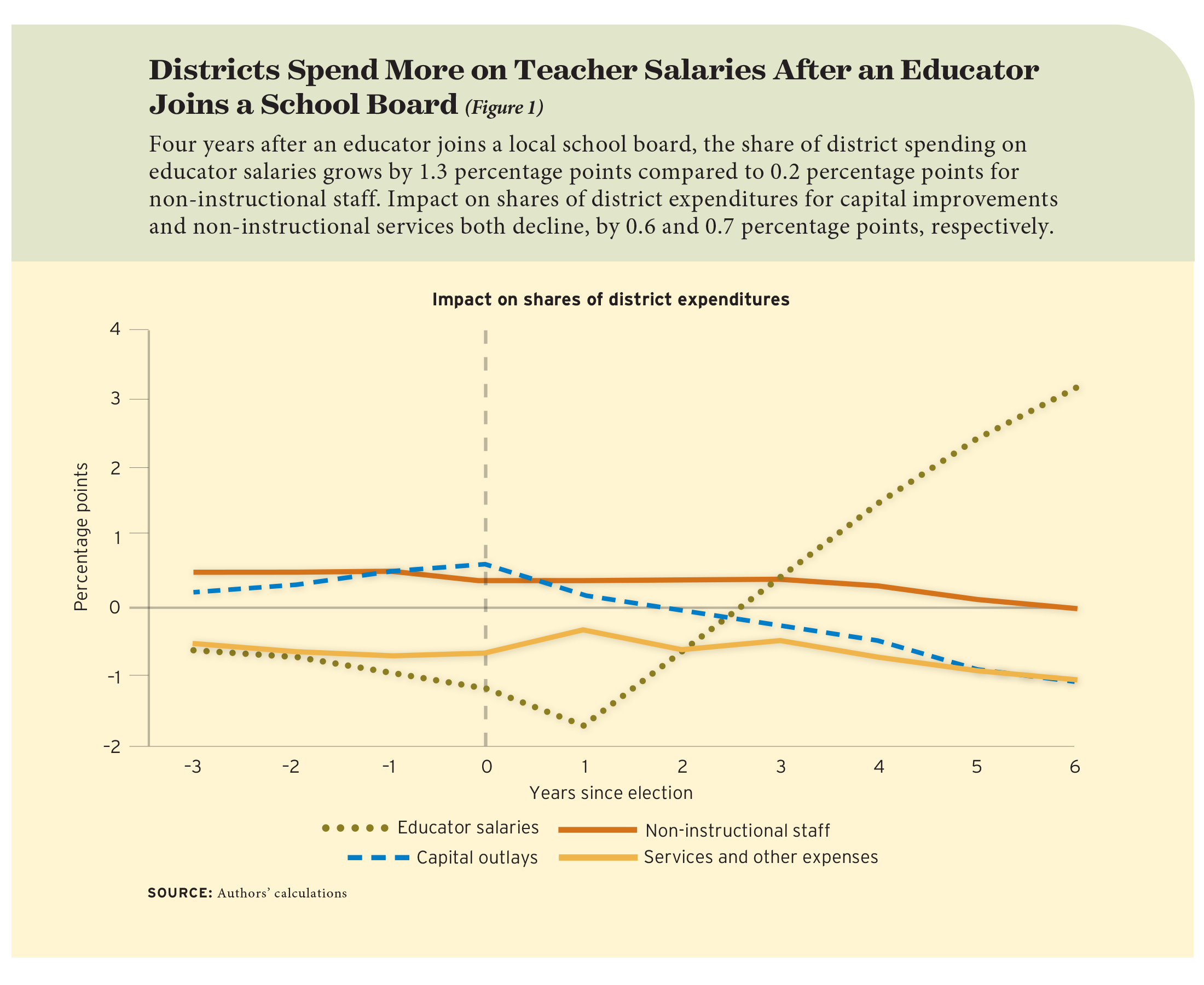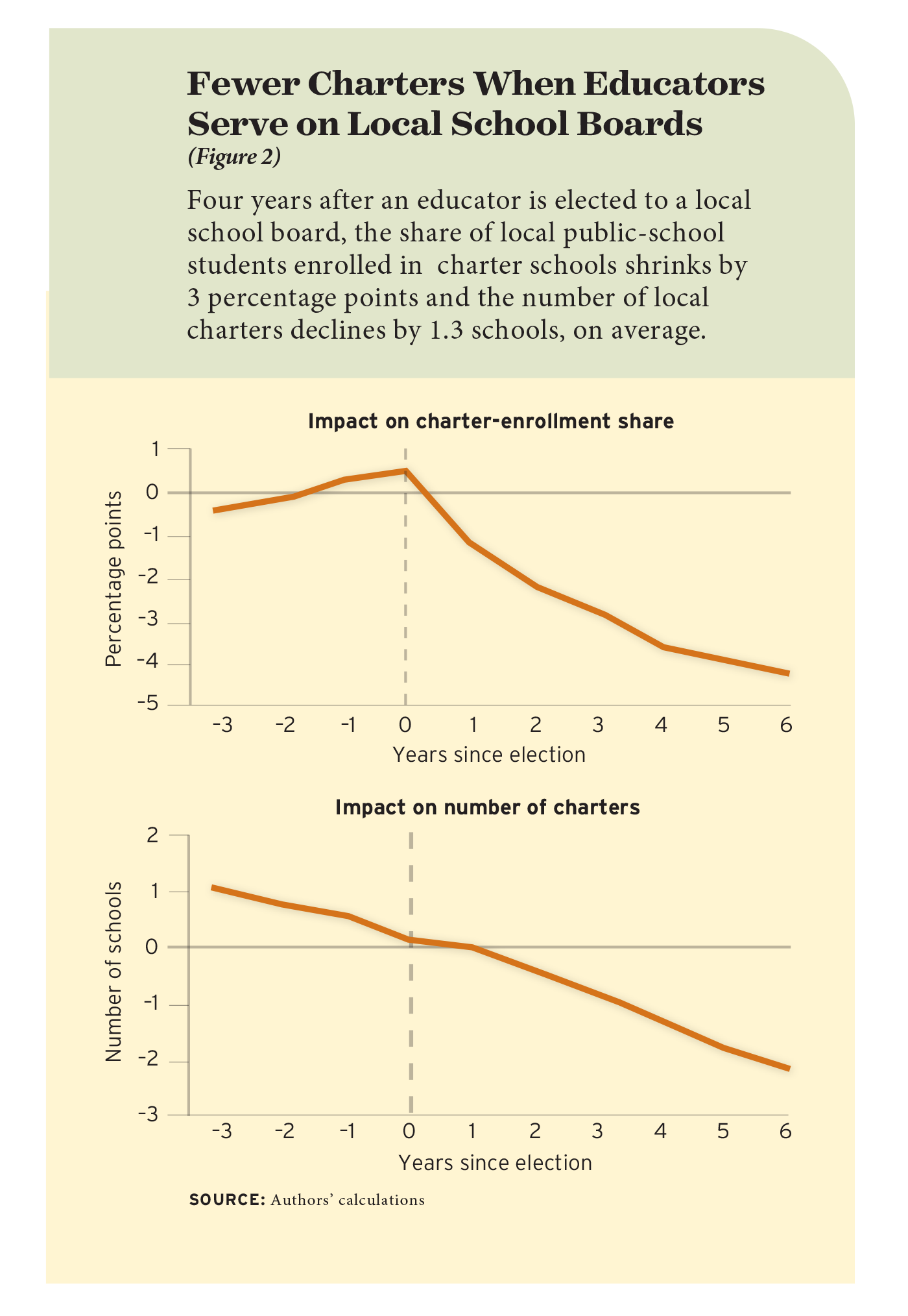
Public K–12 education in the United States is distinctively a local affair: school districts are governed by local boards of education, composed of lay members typically elected in non-partisan elections. These boards have decision-making power over hundreds of billions of public dollars and oversee complex agencies that, in addition to preparing a community’s children for the future, can be the biggest employer in town. Yet we know very little about what factors influence a board’s governance and impact, including the professional backgrounds of elected members.
One profession would seem to have particularly relevant effects: educators. Organizations like the National Education Association and Leadership for Educational Equity, the political arm of Teach for America, are training and supporting their educator members and alumni to run for elected offices. What might be the impacts of such efforts on school board elections, district governance, and student outcomes?
Research focused on boards of directors, which play a similar role in the corporate world, has found that adding members with more industry expertise increases a firm’s value. It stands to reason that electing educators to school boards could have similarly beneficial effects. For example, former classroom teachers or school leaders with firsthand knowledge of common challenges could theoretically make better decisions about teachers’ working conditions and positively influence student performance.
On the other hand, 70 percent of U.S. teachers are members of teachers unions. This raises the possibility that educators serving on school boards could be influenced not only by expertise but also allegiance to union priorities. That could theoretically influence collective bargaining, which is one of the major responsibilities of a school board. Union allegiance could shift bargaining agreements toward union goals, such as increasing teacher salaries or limiting charter-school growth, which may not necessarily benefit students.
We investigate these possibilities in California. State election rules randomize the order of candidates’ names on the ballot, which allows us to estimate the causal effects of an educator serving on a school board. By looking at randomized ballot order, candidate filings, election records, and school district data, we provide the first evidence on how the composition of local school boards affects district resource allocation and student performance.
Our analysis finds no impact on student achievement from an educator serving on a school board; neither average test scores nor high-school graduation rates improve. However, outcomes relevant to union priorities advance. Relative to a district without an educator on the school board, charter-school enrollment declines and the number of charter schools shrinks by about one school on average during an elected educator’s four-year board term.
In addition, each educator elected to a board leads to an increase of approximately 2 percent in teacher pay, while non-instructional salaries remain flat. Benefits spending is stable, while the share of district spending on ancillary services and capital outlays shrinks. We also find that educators are 40 percent more likely than non-educators to report being endorsed by teachers unions.
Despite raising teachers’ salaries, electing an educator to a school board does not translate into improved outcomes for students and has negative impacts on charter schools. We believe this shows that school boards are an important causal channel through which teachers unions can exert influence.
Electing Educators in California
Nationwide, nearly 90,000 members serve on about 14,000 local school boards. These boards have several general responsibilities, which include strategic planning for the district, curricular decisions, community engagement, budgeting, hiring senior administrators, and implementing federal and state programs and court orders. In addition, in nearly all states, school boards determine contracts for instructional staff through collective-bargaining agreements with teachers unions. These negotiations set salary schedules, benefits, work hours, and school calendars. Local school boards also set attendance zone boundaries and, in about three dozen states, authorize and monitor charter schools. In 2020–21, local education agencies accounted for 90 percent of all charter-school authorizers in the U.S. and enrolled 48 percent of the nation’s charter-school students.
While typical in most respects, school district governance in California has several unique characteristics. First, teachers unions are especially influential: 90 percent of California teachers are full voting union members. Second, school boards effectively do not have the power to tax. Under Proposition 13, property-tax collections are capped at 1 percent of assessed value, and assessments are adjusted only when a property is sold. Finally, charter authorization is overwhelmingly a local issue, with about 87 percent of California charters authorized by local school districts. Los Angeles Unified School District is the single biggest local authorizer in the U.S. and enrolls 4 percent of all charter-school students nationwide.
Our analysis is based on records from the California Elections Data Archive for all contested school board elections from 1996 to 2005. The data include each candidate’s vote share, ballot position, electoral outcome, and occupational background. We identify as educators candidates who describe their primary occupation or profession as a teacher, educator, principal, superintendent, or school administrator. Educators account for 16 percent of all 14,150 candidates in contested races and 19 percent of all 7,268 winners during this period.
Almost all school-board members serve four-year terms with staggered contests occurring every two years. The average tenure is seven years, and the average school board has five members. We use candidate-level records to construct yearly measures of school-board composition in each district, including the share of members who are educators. On the average school board, educators account for 18 percent of members. We link school-board rosters with district-level characteristics and charter-school campus and enrollment counts from the federal Common Core of Data, as well as negotiated salary schedules and district finance information from the state Department of Education. To look at impacts on student outcomes, we include average test scores in elementary and middle schools along with high-school graduation rates, also from the state education department.
Investigating Educator Impacts
To estimate the causal effects of an educator being elected to a school board, we need to compare two sets of circumstances: what happens after an elected educator joins the board and what would have happened if the educator had not won. While the effects could appear immediately and persist over time, it is also possible that they only become apparent in the longer run. Our approach therefore must examine the profile of effects over time.
The key challenge we face in making these comparisons is that the school districts that elect educators likely differ from those that do not—and these other differences could be responsible for any policy outcomes that change after an educator’s election. To overcome this challenge, we take advantage of the fact that, under California law, the order in which candidates for elected office appear on the ballot is randomly determined. Our data confirm that candidates who have the good fortune of being listed first on the ballot gain an advantage of 10.3 percentage points of the votes cast in their election. When an educator is listed first, this advantage translates into a 2.3 percentage point increase in the share of the board’s members who are educators. In short, the random assignment of an educator to the top of a ballot will shift a board’s composition.
Armed with this insight, we compare the policy choices of districts where educators are and are not listed first to isolate the causal effects of adding an educator to a school board on student outcomes, district spending, and charter schools. We first look at elementary- and middle-school scores on reading and math tests, as well as high-school graduation rates, and find no impacts.
We then consider teachers’ working conditions and find limited evidence of effects on service days, benefits, or class size. However, when an educator is elected to a school board, teachers’ salaries increase by 2 percent more than they would have otherwise four years after election. These increases apply across the board, for teachers at all levels of education and experience.
Because California school boards cannot raise the tax rate, boards decrease spending on building repairs and services like professional development in order to pay teachers more (see Figure 1). Four years after an educator is elected, a school board has increased the share of spending on certified salaries by 1.3 percentage points and decreased spending on capital outlays and services by 0.6 and 0.7 percentage points, respectively. We do not find evidence for impacts on superintendents’ salaries.

In looking at effects on charter schools, the share of district students enrolled in charters declines by three percentage points (see Figure 2). By the end of an elected educator’s four-year term, there are 1.3 fewer charter schools in the district. In a state with an active charter sector serving at least one out of every 10 public-school students, these are sizeable impacts.

What if a school board includes multiple educators? That could shift the identity of the median board “voter” for a given issue and influence board decisions through deliberations and agenda-setting. To examine these possibilities, we estimate the effects of electing an educator to a school board if it already has a sitting member who is an educator. Our results suggest that this is of limited importance. There are slightly larger negative effects on charter school enrollment, but these are not statistically significant.
We also investigate whether electing an educator to a school board has consequences for subsequent elections and find evidence that it does. In this analysis, we look again at the effect of ballot order. An educator being listed first increases the number of elected educators in that election by 13 percent but decreases the number of elected educators by 9 percent in the next election. Interestingly, educators are no less likely to run in these subsequent elections; those who do run are just less likely to win. The long-term causal effects of electing an additional educator would be even larger in the absence of this electoral dynamic.
The Influence of Teachers Unions
Our findings suggest that educators’ professional expertise on boards does not translate into improvements in student learning. The results are consistent with a rent-seeking framework, in which representation of union interests predicts higher teachers’ salaries and potentially negative effects on student performance. Our own data reveal that educators are 40 percent more likely than non-educators to be endorsed by a teachers union. School board member survey data also indicate a strong positive association between professional experience in education and alignment with union priorities.
We conclude that school boards may be an important causal mechanism for the influence of teachers unions on local education, which points to several avenues for future research. Our ballot-order-based strategy provides a new approach to inferring how the characteristics of candidates causally affect outcomes. A valuable next step would be to analyze candidate-level records of union endorsement. This would facilitate separating out the influence of educators on education production from their possible alignment with teachers unions. Likewise, shifting from aggregate school-level to administrative student records would enable disentangling impacts on student sorting from their effects on education quality. Future work should also focus on broader dimensions of students’ skills and behavior, such as social-emotional attributes and civic engagement.
In summary, the election of an educator to a local school board shifts spending priorities on K–12 public schools, which collectively cost about $800 billion in federal, state, and local tax dollars a year. Yet voter turnout in school-board elections is typically between 5 and 10 percent. While more research is needed, voters don’t need to wait. Our results show just how much these races matter.
Ying Shi is assistant professor at Syracuse University and John G. Singleton is assistant professor at the University of Rochester.
This article appeared in the Summer 2023 issue of Education Next. Suggested citation format:
Shi, Y., and Singleton, J.D. (2023). Putting Teachers on the Ballot: Raises for teachers, fewer charters when educators join the school board. Education Next, 23(3), 56-60.


